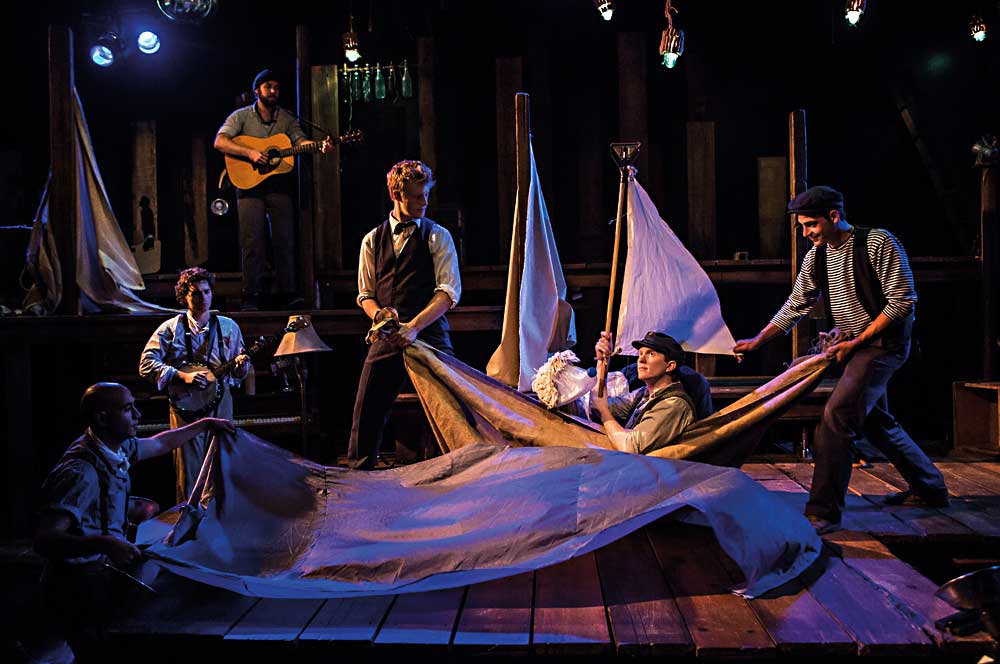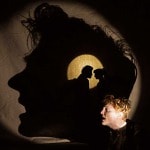(In honor of the New York re-premiere of The Old Man and the Old Moon, currently at the New Victory Theater, we are reposting our story from March, 2014 about the design of the show when it was at Writers Theatre in Chicago.)
PigPen Theatre Company’s The Old Man and The Old Moon is a new folktale about an old man who abandons his daily task of filling the moon with light to follow his wife on a fantastical adventure. Through the use of found objects, shadow puppetry, folk music, and a few stage tricks, the seven-member ensemble, with the help of innovative designers (all of whom met while attending Carnegie Mellon) create magic onstage. Company member Matt Nuernberger, designer Bart Cortright and co-director and Writers Theatre associate artistic director Stuart Carden (the team’s former professor) take us behind the trickery.
 MATT NUERNBERGER: When we were in college, we didn’t have any money, so we ended up using a lot of cardboard and found-object puppetry. We spent a lot of our free time when we were developing this show coming up with different effects and things that would immerse the audience into the world of the play. Rather than having a huge, sweeping town, we wanted to use the power of suggestion and engage the imagination. When we’re talking specifically about design, it’s not about your role, my role—it’s about what the idea is, and what we’re trying to get across. In all of our shows, we strive to create the sense of play and wonder that we have in the rehearsal room. We want to make the audience feel like their imaginations are being engaged in the same way ours are when we’re developing the show.
MATT NUERNBERGER: When we were in college, we didn’t have any money, so we ended up using a lot of cardboard and found-object puppetry. We spent a lot of our free time when we were developing this show coming up with different effects and things that would immerse the audience into the world of the play. Rather than having a huge, sweeping town, we wanted to use the power of suggestion and engage the imagination. When we’re talking specifically about design, it’s not about your role, my role—it’s about what the idea is, and what we’re trying to get across. In all of our shows, we strive to create the sense of play and wonder that we have in the rehearsal room. We want to make the audience feel like their imaginations are being engaged in the same way ours are when we’re developing the show.
BART CORTRIGHT: There’s a scene where someone’s drowning, and basically he holds a flashlight on himself to project his face onto a shadow screen (in photo gallery below). Then, from behind, some of the other members use flashlights and cardboard cutouts of objects to show the memories that pass through his head as he’s drowning. So there’s a giant head, and within that head, there are images of a house and a window and his wife and many others. That’s a good example of the dual-layered shadow puppetry that we do.
The first time that I ever lit the show, [company member] Arya Shahi wanted me to light it with just practicals. A practical is something that we make into a somewhat theatrical instrument—for example, I’ll take an old 12-volt lantern and wire it up with an MR16, and it will run 120 volts that can be controlled in the board. There were six or seven of those lanterns in this piece. My fellow designer Lydia Fine and I make almost all of the practicals. At Writers, there were about 80 practicals and 50 theatrical lights—the latter are just helping to bring up the level of light. All of the props and lights are found material, so nothing feels contrived.
 STUART CARDEN: In this production, we added a lot more levels and planes for the actors to create a kind of theatrical playground, which would also serve as the multiple projection spaces that we needed for the shadow puppetry. Lydia Fine created a continuation of the audience’s seating banks in the upper planking and deck of our design, and created a real sense of the epic in our very intimate thrust space. The handmade, DIY aesthetic makes it seem that you could go home after you see the show and grab a few objects from around your house and create your own version of what you’ve seen. Audiences leave inspired to go create for themselves.
STUART CARDEN: In this production, we added a lot more levels and planes for the actors to create a kind of theatrical playground, which would also serve as the multiple projection spaces that we needed for the shadow puppetry. Lydia Fine created a continuation of the audience’s seating banks in the upper planking and deck of our design, and created a real sense of the epic in our very intimate thrust space. The handmade, DIY aesthetic makes it seem that you could go home after you see the show and grab a few objects from around your house and create your own version of what you’ve seen. Audiences leave inspired to go create for themselves.
The Old Man and The Old Moon, by the PigPen Theatre Company, ran July 14–23, 2011, at The Yard in Martha’s Vineyard, Mass.; Sept. 26–Jan. 6, 2013, at The Gym at Judson in New York City; and Sept. 3–Dec. 1, 2013, at Writers Theatre in Glencoe, Ill., all directed by PigPen Theatre Company and designed by Bart Cortright and Lydia Fine. The Writers Theatre production featured co-direction by Stuart Carden and sound design by Mikhail Fiksel.






